
(Struve Arc)

The United Nations Educational, Scientific and Cultural Organization (UNESCO) World Heritage Sites are places of importance to cultural or natural heritage as described in the UNESCO World Heritage Convention, established in 1972. Cultural heritage consists of monuments (such as architectural works, monumental sculptures, or inscriptions), groups of buildings, and sites (including archaeological sites). Natural features (consisting of physical and biological formations), geological and physiographical formations (including habitats of threatened species of animals and plants), and natural sites which are important from the point of view of science, conservation or natural beauty, are defined as natural heritage. The Soviet Union ratified the convention on 12 October 1988. The first five sites in the Soviet Union were inscribed to the list at the 14th session of the UNESCO World Heritage Committee, held in Banff, Alberta, Canada, in December 1990. Of these five, three are located in the present-day Russian Federation (or Russia): the monuments of Saint Petersburg (then called Leningrad), Kizhi Pogost, and Moscow Kremlin and Red Square.
As of 2024, there are 32 World Heritage Sites in Russia, with a further 31 sites on the tentative list. The most recent site listed was the Cultural Landscape of Kenozero Lake, in 2024. There are twenty-one cultural sites and eleven natural. Four sites are transnational. The Curonian Spit is shared with Lithuania, the Landscapes of Dauria and Uvs Nuur Basin are shared with Mongolia, and the Struve Geodetic Arc is shared with nine European countries.
World Heritage Sites
UNESCO lists sites under ten criteria; each entry must meet at least one of the criteria. Criteria i through vi are cultural, and vii through x are natural.
* Transnational site| Site | Image | Location | Year listed | UNESCO data | Description |
|---|---|---|---|---|---|
| Historic Centre of Saint Petersburg and Related Groups of Monuments | 
|
Saint Petersburg | 1990 | 540; i, ii, iv, vi (cultural) | Saint Petersburg was conceived by Tsar Peter the Great as a new capital and a port city at the banks of the Neva River, at the Gulf of Finland. The city was constructed in the early 18th century on a difficult terrain of marshes, peatlands, and rocks. The World Heritage Site comprises the historic centre of the city with its Baroque and Neoclassical architecture, as well as surrounding monuments and palaces, such as those in Pushkin and Petergof. Notable buildings in the city include the Winter Palace (pictured, home of the Hermitage Museum), the Admiralty, and the Marble Palace. In the 20th century, the city was the site of the October Revolution and the Siege of Leningrad during World War II. |
| Kizhi Pogost | 
|
Karelia | 1990 | 544; i, iv, v (cultural) | The architectural ensemble of the Kizhi Pogost (enclosure) on the Kizhi Island in the Lake Onega comprises two wooden churches from the 18th century (the Church of the Transfiguration and the Church of the Intercession) and a clock tower from 1862. They were built in a unique artistic style and represent a culmination of Russian carpenter techniques. Although the buildings have seen periodic repairs, they have not been significantly reconstructed. |
| Kremlin and Red Square, Moscow | 
|
Moscow | 1990 | 545; i, ii, iv, vi (cultural) | The Moscow Kremlin is the oldest part of Moscow, first mentioned in 1147. In the 13th century, it served as the seat of the Grand Duchy of Moscow and a religious centre. The walls and the towers were constructed in the late 15th and early 16th century, as well as the churches that were designed by invited Italian architects and show influences of the Italian Renaissance. The Assumption Cathedral was the site of coronations and the Cathedral of the Archangel served as the burial site of Russian princes and tsars. Civic buildings were constructed in the 18th and 19th centuries. Red Square is located outside the Kremlin walls. Saint Basil's Cathedral, located at the end of Red Square, is pictured. |
| Historic Monuments of Novgorod and Surroundings | 
|
Novgorod Oblast | 1992 | 604; ii, iv, vi (cultural) | Novgorod was the first capital of Kievan Rus' in the 9th century and the capital of the Novgorod Republic from the 12th to the 15th centuries. Located at the intersection of trade routes linking Northern Europe with Central Asia and Byzantine Empire, the city grew to one of the most important centres of Russian art and culture, as well as a spiritual centre. The majority of the preserved monuments in the city, such as churches and monasteries, are from the Novgorod Republic period. The Kremlin is pictured. |
| Cultural and Historic Ensemble of the Solovetsky Islands | 
|
Arkhangelsk Oblast | 1992 | 632; iv (cultural) | Six islands of the archipelago in the White Sea have been inhabited at least since the 5th century BCE. A fortified Solovetsky Monastery was founded in the 1430s and remained active until the 1920s when it was converted into a prison camp under the Gulag system. The prison camp closed in 1939 and the complex has since returned to the Orthodox church. The World Heritage Site comprises the monastery complex, a former monastic village, monastic cells and hermitages, prehistoric sites, memorial sites of the prison camp, and the surrounding cultural landscape shaped by people living in remote and harsh conditions of the North. |
| White Monuments of Vladimir and Suzdal | 
|
Vladimir Oblast | 1992 | 633; i, ii, iv (cultural) | Vladimir and Suzdal were the main towns of the Vladimir-Suzdal principality in the 12th and 13th centuries. The World Heritage Site comprises the monuments in a unique architectural style developed in the region. The monuments are the Cathedral of the Assumption, the Cathedral of Saint Demetrius, and the Golden Gate in Vladimir, the Princely Castle and the Church of the Intercession on the Nerl in Bogolyubovo, Suzdal Kremlin, the Cathedral of the Nativity, and the Monastery of Our Savior and St Euthymius (pictured) in Suzdal, and the Church of Sts Boris and Gleb in Kideksha. |
| Architectural Ensemble of the Trinity Sergius Lavra in Sergiev Posad | 
|
Moscow Oblast | 1993 | 657; ii, iv (cultural) | The monastery in Sergiev Posad is the most important Russian monastery and the spiritual centre of the Russian Orthodox Church, as well as the seat of the Patriarch. It was founded in 1337 and developed through centuries. The Trinity Cathedral dates from 1422 and houses Andrei Rublev's most famous icon, The Trinity. The Assumption Cathedral, from the second half of the 16th century, houses the tomb of Tsar Boris Godunov and his family. The complex is surrounded by thick defensive walls that protected it during the Polish-Lithuanian siege of 1610. |
| Church of the Ascension, Kolomenskoye | 
|
Moscow | 1994 | 634rev; ii (cultural) | The Church of the Ascension was built in 1532 to commemorate the birth of the future Tsar Ivan the Terrible. The church is significant because of its tented roof built in stone, an architectural novelty in Russian architecture; such roofs were previously constructed in wooden structures. The roof rises from an octagonal base and features several decorative elements called kokoshniks. The church had a strong influence on the architecture of Russian churches until the middle of the 17th century. |
| Virgin Komi Forests | 
|
Komi Republic | 1995 | 719; vii, ix (natural) | Virgin forests of this World Heritage Site cover 32,000 square kilometres (12,000 sq mi) in the Ural Mountains. They consist of boreal forest (taiga), tundra, and alpine tundra. The most common tree species are conifers, aspens, and birches. There are also extensive peatlands. |
| Lake Baikal | 
|
Irkutsk Oblast, Buryatia | 1996 | 754; vii, viii, ix, x (natural) | At a depth of 1,700 metres (5,600 ft), Lake Baikal is the deepest lake in the world and contains about 20% of world's unfrozen fresh water. It is also the oldest lake in the world, with an age of 25 million years. Due to its characteristics, it is home to a unique combination of freshwater flora and fauna, with many endemic species. |
| Volcanoes of Kamchatka | 
|
Kamchatka Krai | 1996 | 765bis; vii, viii, ix, x (natural) | The Kamchatka Peninsula contains a large density of active volcanoes and associated volcanic features, there are also many glaciers. The area is home to species such as sea otter, brown bear, white-tailed eagle, and Steller's sea eagle. The rivers are spawning areas for salmonid species. The boundaries of the property were expanded in 2001 to include six areas in total. Klyuchevskaya Sopka volcano is pictured. |
| Golden Mountains of Altai | 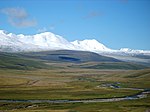
|
Altai Republic | 1998 | 768rev; x (natural) | This site comprises the Altai and Katun Natural Reserves, Lake Teletskoye, Belukha Mountain, and the Ukok Plateau. The area is important in view of biodiversity, with altitudinal vegetation zones spanning from steppe, forest steppe, mixed forest, to subalpine and alpine vegetation. It is also home to snow leopard. |
| Historic and Architectural Complex of the Kazan Kremlin | 
|
Tatarstan | 2000 | 980; ii, iii, iv (cultural) | Tsar Ivan the Terrible conquered the city of Kazan from the Khanate of Kazan (successors to the Golden Horde) in 1552 and built the Kremlin upon the site of a Tatar fortress. The buildings in the citadel, most of them erected between the 16th and the 19th centuries, reflect the interaction of Russian and Tatar influences, as well as Christian and Muslim faiths. The Kul Sharif Mosque is a new structure, constructed in the 21st century on the site of an earlier mosque. |
| Western Caucasus | 
|
Krasnodar Krai | 1999 | 900; ix, x (natural) | This site comprises seven properties (including the Caucasus Nature Reserve) in the western part of the Caucasus mountains, that represent one of the few mountain forest areas that have not been significantly modified by human activities. They contain a wide variety of ecosystems from lowlands to subalpine zone. They are home to several animal and plant species and are the site of reintroduction of the mountain subspecies of the European bison. |
| Ensemble of the Ferapontov Monastery | 
|
Vologda Oblast | 2000 | 982; i, iv (cultural) | The monastery was founded by Saint Ferapont in 1398 in the inhospitable Russian North. The buildings date from the 15th to the 17th century, with a stone wall added in the 19th century. The monastery is a prime example of a Russian Orthodox monastic community from the period, and has been well preserved. The Cathedral of the Nativity of the Virgin (built in 1490 by masters from Rostov) has interior walls covered by frescos by master Dionisius. |
| Curonian Spit* | 
|
Kaliningrad Oblast | 2000 | 994; v (cultural) | The Curonian Spit, a 98-kilometre (61 mi) long sandy dune (a spit) that separates the Curonian Lagoon from the Baltic Sea, has been inhabited since prehistoric times. Intense logging activities in the 17th and 18th centuries resulted in the dunes moving towards the Lagoon, burying the oldest settlements in the process. Dune stabilization work started in the 19th century and is still ongoing. It includes building a protective dune ridge, as well as planting trees and hedges. In time, some of the ancient fishermen villages have been transformed into tourist resorts, with lighthouses, piers, churches, schools, and villas. The area is also important for its sand flora and fauna, and as a bird migration path. The northern part of the Spit is in Lithuania, while the southern part is in Kaliningrad Oblast in Russia. |
| Central Sikhote-Alin | 
|
Primorsky Krai | 2001 | 766bis; x (natural) | This site comprises three properties in the Sikhote-Alin mountain range: Sikhote-Alin Nature Reserve, Goralij Zoological Preserve, and the Bikin River Valley (added as an extension in 2018, pictured). The temperate forests represent a unique meeting point between the taiga and the subtropics, and are home to species such as the Siberian tiger, Himalayan black bear, Siberian musk deer, wolverine, and sable. |
| Uvs Nuur Basin* | 
|
Tuva | 2003 | 769rev; ix, x (natural) | This transnational site comprises seven properties in Russia and five in Mongolia. The Uvs Nuur Basin is a large endorheic basin that drains into the large, shallow, and very saline Uvs Lake. The basin contains a wide variety of habitats, including wetlands, steppe, different types of forests, fresh and saltwater ecosystems, as well as mountain tundra. The area is home to several bird species, snow leopard, Mongolian gerbil, argali, and Siberian ibex. |
| Citadel, Ancient City and Fortress Buildings of Derbent | 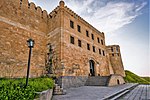
|
Dagestan | 2003 | 1070; iii, iv (cultural) | Derbent, the oldest city in Russia, is located on a narrow plain between the Caspian Sea and the Caucasus mountains. Due to its strategic position between Europe and Asia, defensive structures were built already in the first millennium BCE to control the passage. Two parallel walls were built in the 5th and 6th century CE by the Sassanian Empire, parts of them surviving to the present day. The citadel and the city that developed between the walls were shaped by the Arab, Seljuk, Mongol, Timurid, and Safavid rule. The area came under the Russian Empire in the 19th century and gradually lost its military function. |
| Natural System of Wrangel Island Reserve | 
|
Chukotka Autonomous Okrug | 2004 | 1023rev; ix, x (natural) | Wrangel Island is located in the Arctic Ocean between the Chukchi Sea and East Siberian Sea. As it was not covered by ice during the Quaternary glaciation, it preserved a large number of plant communities that were otherwhere disrupted by ice, and keeps the highest biodiversity of all Arctic islands. It was also the site of the last known surviving woolly mammoths. In addition to the main island, the site also includes the smaller Herald Island and the surrounding waters. The area is home to seabirds, snow geese, and a large walrus colony, and is a major feeding ground for gray whales. |
| Ensemble of the Novodevichy Convent | 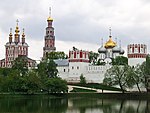
|
Moscow | 2004 | 1097; i, iv, vi (cultural) | The monastery was founded in the 1520s. The complex was constructed in the 16th and 17th centuries in the Muscovite Baroque style, and is the representative example of the style that was popular in the region in that period. It was closely linked to the royal family, as the chosen convent for women of aristocratic and wealthy families who became nuns, as well as the burial site for the nobles. The convent is surrounded by walls that were, at the time of construction, integrated into Moscow's defenses. |
| Historical Centre of the City of Yaroslavl | 
|
Yaroslavl Oblast | 2005 | 1170; ii, iv (cultural) | The city of Yaroslavl is located at the confluence of the Volga and Kotorosl rivers. Founded in the 11th century as a small wooden fortress, it developed into a strong commercial centre after being incorporated into the Grand Duchy of Moscow in 1463. Several churches from the 16th and 17th centuries are preserved. Following the town-planning reform of Empress Catherine the Great at the end of the 18th century, Yaroslavl's centre was redesigned in a Neoclassical style with a radial urban plan. |
| Struve Geodetic Arc* | 
|
Leningrad Oblast | 2005 | 1187; ii, iii, vi (cultural) | The Struve Geodetic Arc is a series of triangulation points, stretching over a distance of 2,820 kilometres (1,750 mi) from Hammerfest in Norway to the Black Sea. The points were set up in a survey by the astronomer Friedrich Georg Wilhelm von Struve who first carried out an accurate measurement of a long segment of a meridian, which helped to establish the size and shape of the Earth. Originally, there were 265 station points. The World Heritage Site includes 34 points in ten countries (North to South: Norway, Sweden, Finland, Russia, Estonia, Latvia, Lithuania, Belarus, Moldova, Ukraine), two of which are in Russia, on the island of Gogland. |
| Putorana Plateau | 
|
Krasnoyarsk Krai | 2010 | 1234rev; vii, ix (natural) | Putorana Plateau is the northernmost part of the Central Siberian Plateau. Geologically, it is mainly composed of basalt from the Siberian Traps. This remote and mostly untouched area includes several ecosystems, such as taiga, forest tundra, tundra, Arctic deserts, lakes, and rivers. The vegetation marks the meeting point between Western and Eastern Siberian floras. The plateau is on a major reindeer migration route. |
| Lena Pillars Nature Park | 
|
Sakha | 2012 | 1299bis; viii (natural) | Lena Pillars are a natural formation overlooking the Lena River. The pillars, reaching up to 200 metres (660 ft) in height, were formed by harsh continental climate with cold winters, with temperatures far below freezing, and hot summers, resulting in freeze-thaw action widening the intervening joints between the rocks. The pillars consist of Cambrian rocks and contain fossils documenting the early differentiation of species during the Cambrian explosion. A minor boundary modification took place in 2015. |
| Bolgar Historical and Archaeological Complex | 
|
Tatarstan | 2014 | 981rev; ii, vi (cultural) | Bolghar was the intermittent capital of Volga Bulgaria, a Bulgar state between the 7th and 15th centuries. Following the Mongol invasion in the 13th century, it became an early capital of the Golden Horde and remained an important trade centre during the Khanate of Kazan. The state adopted Islam as official religion in 922 and Bolghar still remains a pilgrimage site of the Volga Tatars. |
| Landscapes of Dauria* | 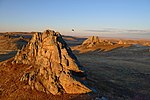
|
Zabaykalsky Krai | 2017 | 1448rev; ix, x (natural) | Dauria, or Transbaikal, is a region east of Lake Baikal. The transnational site comprises areas of Daursky Nature Reserve in Russia and three areas in Mongolia, including the Mongol Daguur Biosphere Reserve. The landscape includes different steppe ecosystems, forests, and grasslands, as well as wetlands and lakes. The area is important as a nesting ground or migration route for several bird species, such as the white-naped crane, and is also a migration area of the Mongolian gazelle. |
| Assumption Cathedral and Monastery of the town-island of Sviyazhsk | 
|
Tatarstan | 2017 | 1525; ii, iv (cultural) | The town-island, located at the confluence of the Volga, the Sviyaga, and the Shchuka rivers, was founded in 1551 by Ivan the Terrible. Located at a strategic position at a crossroads of Volga route and Silk Road, it was the initial outpost for Ivan's conquest of the Khanate of Kazan. The cathedral and the monastery complex were built in the 16th and renovated in the 18th century. The frescos in the cathedral are among the best examples of Russian Orthodox paintings and are painted in a unique fusion of styles from different regions of Russia. |
| Churches of the Pskov School of Architecture | 
|
Pskov Oblast | 2019 | 1523; ii (cultural) | This site comprises ten churches or monasteries and related buildings in the city of Pskov. They represent the work of the Pskov School that drew from the Byzantine and Novgorod traditions, fused them with the local vernacular tradition, and adjusted the architecture to the use of local resources. The churches date from the 12th to the early 17th century, with the peak of this style in the 15th and 16th centuries. The architects from Pskov worked on monuments in several Russian cities, including Moscow, Kazan, and Sviyazhsk. The Cathedral of St. John from the 12th century is pictured. |
| Petroglyphs of Lake Onega and the White Sea | 
|
Karelia | 2021 | 1654; iii (cultural) | This site comprises 33 properties with petroglyphs in two clusters. The petroglyphs at Lake Onega depict birds, animals, half human and half animal figures, as well as geometric shapes possibly representing the moon and the sun. The petroglyphs at the White Sea represent hunting and sailing scenes, together with related equipment, as well as animal and human footprints. They were created 6 and 7 thousand years ago and provide an insight into the lives of Neolithic cultures of Fennoscandia. |
| Astronomical Observatories of Kazan Federal University | 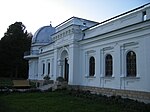
|
Tatarstan | 2023 | 1678; i, ii, iv, vi (cultural) | This nomination comprises two astronomical observatories. The one at Kazan Federal University was founded in the early 19th century and the one at Engelhardt (pictured) in 1901. They were used to map the positions of stars and objects of the Solar System, as well as to develop astronomical instruments. |
| Cultural Landscape of Kenozero Lake | 
|
Arkhangelsk Oblast | 2024 | 1688; iii (cultural) | The national park encompasses a cultural landscape that was shaped by farmers through centuries between the 12th and 16th centuries. The area is covered by taiga and there are several lakes, the biggest two being Lake Kenozero and Lake Lyokshmozero. There are several wooden churches (St. George's church from the 18th century in Porzhensky Pogost pictured), chapels, holy crosses, and sacred groves. |
Tentative sites
In addition to sites inscribed on the World Heritage List, member states can maintain a list of tentative sites that they may consider for nomination. Nominations for the World Heritage List are only accepted if the site was previously listed on the tentative list. As of 2024, Russia recorded 31 sites on its tentative list.
| Site | Image | Location | Year listed | UNESCO criteria | Description |
|---|---|---|---|---|---|
| Historical and Cultural Dzheyrakh-Assa Reservation | 
|
Ingushetia | 1996 | (cultural) | The museum-reserve comprises 18 settlements in the canyons of the Assa and Armkhi rivers. The settlements are known for their stone towers (towers in Erzi pictured) that had both residential and defensive functions. Most date from the 16th and 17th centuries. |
| Historic Centre of Irkutsk | 
|
Irkutsk Oblast | 1998 | (cultural) | The city of Irkutsk, located at the Irkut and Angara rivers 66 kilometres (41 mi) from Lake Baikal, has been shaped by its history spanning over 300 years. Founded in 1661 as a military fort, it received many exiles following the 1825 Decembrist revolt. It saw large-scale urbanization in the 20th century. Several buildings from different time periods have been preserved, including traditional decorated wooden houses (example pictured) and buildings in Siberian Baroque. |
| Rostov Kremlin | 
|
Yaroslavl Oblast | 1998 | ii, iii, iv, vi (cultural) | The Kremlin in the town of Rostov overlooks the Lake Nero. It initially consisted of three parts that were integrated together in the 17th century. The Kremlin contains the Metropolitan residence, several churches, and it is surrounded by high walls. It is one of the best preserved examples of old Russian architecture. |
| Historic Center of Yeniseysk | 
|
Krasnoyarsk Krai | 2000 | ii, iii, iv (cultural) | The town of Yeniseysk was founded in 1619 and served as a base for Russian expansion into East Siberia. Located at the bank of the Yenisey River, it was also an important trade centre. The town preserves several buildings from the 18th and 19th centuries. The Monastery of the Transfiguration of the Savior is pictured. |
| Petroglyphs of Sikachi-Alyan | 
|
Khabarovsk Krai | 2003 | (cultural) | Petroglyphs dating to the prehistoric times are located on cliffs above the Amur River near the village of Sikachi-Alyan. They were noticed by the Russian orientalist Palladius in the late 19th century and were further studied in the 20th century. |
| The Commander Islands (Comandorsky State Nature Reserve) | 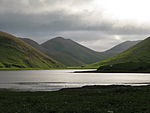
|
Kamchatka Krai | 2005 | vii, viii, ix, x (natural) | The nature reserve comprises two large islands (Bering Island and Medny Island, pictured), a group of smaller islands, and the surrounding waters. The islands are the peaks of a submarine volcanic ridge extending from Alaska to Kamchatka. The islands are an important habitat for birds and sea mammals. |
| Magadansky State Nature Reserve | 
|
Magadan Oblast | 2005 | vii, viii, ix, x (natural) | The reserve consists of four clusters, three of which are at or near the coast of the Sea of Okhotsk and the fourth is further inland. The climate in the area is subarctic. The forests consist mainly of conifers and there are several endemic plant species. The rivers are important for migrating species of salmons. |
| Krasnoyarsk Stolby | 
|
Krasnoyarsk Krai | 2007 | vii, viii, ix, x (natural) | The stolby (rocks) are rock formations in the Eastern Sayan Mountains. The rocks date to the Paleozoic era, they are of magmatic and sedimentary origin, and contain fossils from the Cambrian period. There are also karst phenomena, such as caves, present. The area is popular with rock climbers, who call the freestyle mountaineering "stolbism". |
| The Great Vasyugan Mire | 
|
Tomsk Oblast | 2007 | vii, viii, ix, x (natural) | Vasyugan Mire is the largest swamp in the Northern Hemisphere, and is located around the Ob and Irtysh watershed. It developed recently, in the Holocene epoch. The landscape contains peat bogs, fens, and forested mires. The swamp supports large number of insect species, which are in turn food for a large number of migrating and nesting birds. Mammal species present include elk, brown bear, lynx, and sable. |
| Ensemble of the Astrakhan Kremlin | 
|
Astrakhan Oblast | 2008 | ii, iii, iv (cultural) | Following the conquest of the Astrakhan Khanate by Ivan the Terrible, the kremlin of Astrakhan was constructed in 1558, first in wood and then in stone in the following decades. It served as a stronghold in the south-eastern border of Russia and a stop on the Silk Road. The Assumption Cathedral (pictured) is considered as one of the best examples of Russian church architecture of the 18th century. |
| The Ilmensky mountains | 
|
Chelyabinsk Oblast | 2008 | vi, vii, viii (natural) | The mountains contain rich deposits of a wide variety of minerals, some of which were first discovered here. They include ilmenite, monazite, cancrinite, and samarskite-(Y). The area is protected as Ilmen Nature Reserve and generally closed to public. |
| The archeological site of Tanais | 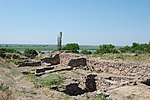
|
Rostov Oblast | 2009 | ii, iii, v (cultural) | Tanais was a colony of Bosporan Kingdom, an ancient Greek state. The city was founded in the 3rd century BCE in the Don river delta and quickly became a strong trade centre and a place of interaction between Greeks and nomadic tribes of the steppe, including the Sarmatians. In the 3rd century CE, Tanais was burned down, probably by the Goths. The area remained inhabited but the centre of settlement has moved away from the city ruins in the following centuries. |
| Bashkir Ural | 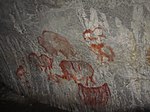
|
Bashkortostan | 2012 | i, iii, v, vi, viii, x (mixed) | The area in the south part of the Ural Mountains is important both in natural and cultural view. It is rich in biodiversity, being at the meeting point of European and Asian forests and steppes. There are several karst phenomena, including caves. Cave paintings from the Paleolithic have been find in Kapova Cave (pictured). Today, the area is inhabited by the Bashkirs who maintain some ancient traditions, including wild beekeeping. |
| Virgin Komi Forests (re-nomination) | 
|
Komi Republic | 2014 | vii, viii, ix, x (natural) | This nomination proposes a boundary modification of the existing World Heritage Site and a further justification of outstanding natural merit as per UNESCO criteria. |
| Western Caucasus (re-nomination) | 
|
Krasnodar Krai | 2014 | ix, x (natural) | This nomination proposes a boundary modification of the existing World Heritage Site. |
| Mamayev Kurgan Memorial Complex "To the Heroes of the Battle of Stalingrad" | 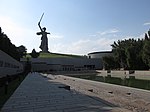
|
Volgograd Oblast | 2014 | i, iv, vi (cultural) | The complex in Volgograd (formerly Stalingrad) commemorates the fallen during the Battle of Stalingrad of World War II. It was constructed between 1959 and 1967. It consists of several staircases, squares, memorial halls, and is crowned by a huge allegorical statue The Motherland Calls by Yevgeny Vuchetich. |
| The Oglakhty Range | 
|
Khakassia | 2016 | i, iii, vi, x (mixed) | The Oglakhty mountain range is located on the bank of the Yenisei river. The area has been inhabited for at least 5000 years and different cultures left several archaeological remains, including petroglyphs and burial sites of the Tashtyk culture from 1st to 7th century CE (funerary mask from this culture pictured). The landscape includes relatively undisturbed forests and steppes with diverse flora and fauna. |
| Historic Centre of Gorokhovets | 
|
Vladimir Oblast | 2017 | ii, iv (cultural) | The town of Gorokhovets was founded in the 12th century on the bank of Klyazma river, to protect the southern border of Vladimir-Suzdal. The town saw its golden age in the 17th and 18th centuries when it was an important trade centre. A number of churches and monasteries were built in that period. |
| Treasures of the Pazyryk Culture | 
|
Altai Republic | 2018 | i, ii, iii, vi (cultural) | This nomination comprises sites related to the Pazyryk Culture, which was a Scythian nomadic Iron Age archaeological culture from the 6th to 2nd century BCE. Findings include petroglyphs, burial mounds with preserved mummies showing tattoos, as well as remains of textiles (carpet pictured). Some sites are located in the buffer zone of the Golden Mountains of Altai World Heritage Site. |
| Rock Painting of Shulgan-Tash Cave | 
|
Bashkortostan | 2018 | i, iii (cultural) | Cave paintings in the Shulgan-Tash, or Kapova Cave, date to the Upper Paleolithic period. They were made in red ochre and depict mammoths, woolly rhinoceroses, bulls, and horses. The cave was occupied for several thousands of years and likely served ritual purposes. It was rediscovered in the mid-20th century. |
| Cathedral of the Transfiguration of the Savior with the Medieval Rampart City Wall of Pereslavl-Zalessky (1152–1157) | 
|
Yaroslavl Oblast | 2019 | i, ii, iv (cultural) | The Transfiguration Cathedral is the earliest preserved example of Russian white-stone architecture. The design was influenced by the Romanesque style from Western Europe and by Byzantine Empire tradition. The town of Pereslavl-Zalessky was founded by Prince Yuri Dolgorukiy in 1152 and was surrounded by earthen ramparts which are still preserved today. |
| Heritage of Chukotka Arctic Marine Hunters | 
|
Chukotka Autonomous Okrug | 2019 | ii, iii, v, vi (cultural) | This nomination comprises three sites related to the Siberian Yupik (also called Eskimo) people inhabiting the far north of Chukotka. The cemetery complex at Ekven dates from the first millennium AD, the village of Naukan and the complex at Nunak were active from the 15th to the 19th or 20th century. Remains of the Old Bering Sea culture include tools, hunting weapons, household items, and jewellery. Hunters mostly focused on marine mammals and used animal bones to make tools and decorative bone carvings. |
| Vyatskoe village | 
|
Yaroslavl Oblast | 2019 | ii, v (cultural) | The village of Vyatskoe was first mentioned in 1502 but mostly developed in the 18th century. The architecture has been well preserved, including merchant and peasant houses, churches, and public buildings. There are several thematic museums. The villagers have preserved traditional crafts, including the production of pickled cucumbers. |
| Divnogorye Historical and Cultural Complex | 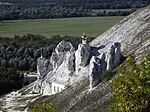
|
Voronezh Oblast | 2020 | ii, iv, v, vi (cultural) | Divnogorye is a chalk and limestone landscape on the bank of the Don river. It has been inhabited since the Upper Paleolithic, when horse hunting took place in the area. In the 9th and 10th centuries, it was a site of a fortified Khazar settlement of Saltovo-Mayaki culture. In the 18th and 19th centuries, the area attracted hermits who carved caves and churches into soft rock (Cave monastery of St. John the Baptist pictured). |
| National Park Kytalyk | 
|
Sakha | 2021 | ix, x (natural) | National park Kytalyk covers parts of the Kolyma Lowland and Yana-Indigirka Lowland and consists of tundra landscape with thermokarst features such as polygonal soils, baydzharakh, and pingos. The area is home to the endangered Siberian crane, as well as several species of ducks and geese. |
| Valley of the Kings of Tuva | 
|
Tuva | 2021 | i, iii, iv (cultural) | The valley of the Uyuk river is the site of thousands of burial mounds (kurgans). They are either stone or earthen and date to the 1st millennium BCE, during the Bronze and Iron Age of the early Scythian cultures. The archaeological studies of the site started in 1915. Some mounds are massive, Arzhaan-1 was originally 120 metres (390 ft) in diameter and 4 metres (13 ft) tall. Thousands of gold objects were discovered in Arzhaan-2 (pictured from above) and are now stored in museums. |
| Denisova Cave | 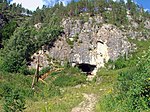
|
Altai Krai | 2022 | iii, v (cultural) | Denisova cave is an archaeological site with remains of Pleistocene communities, with deposits spanning 300,000 years. It was at different times inhabited by Neanderthals, modern humans, and Denisovans, a group of archaic humans that were identified in 2010 by genetic analysis of the bone fragments found in the cave. Subsequent analyses also demonstrated that Denisovans occasionally interbred with Neanderthals, and that they contributed to the genetic pool of the Tibetan people and to populations of South, East, and Southeast Asia. |
| Bashkir Shikhans: Toratau, Yuraktau and Kushtau | 
|
Bashkortostan | 2022 | viii (natural) | This nomination comprises three shikhans, isolated carbonate hills, that are the remains of an ancient reef that formed during the Permian period. They formed at the junction of two ancient oceans, Tethys and Panthalassa, in the final stages before the formation of the Pangaea. They document all the stages of the reef development, from its formation to extinction. Diverse fossil communities include bryozoa, brachiopods, molluscs, and trilobites. Toratau is pictured. |
| The Complex of the Voskresensky Copper Smeltery | 
|
Bashkortostan | 2023 | ii, iv, v (cultural) | The copper smelting industrial complex was established in 1740s as the first private enterprise in the region. The complex later expanded to include iron smelters and foundries. The plant was one of the largest in the Ural Mountains and stimulated development of mining plants in Orenburg Oblast. It ceased operating in 1902. Today, the complex is the best preserved example of a copper smelting plant, with 12 remaining objects, including industrial buildings, a church, a hospital, and warehouses. |
| Historic Town Centre of Torzhok and Country Estate Properties Designed by Nikolay Lvov | 
|
Tver Oblast | 2023 | i, iv, vi (cultural) | Torzhok is one of the oldest Russian towns and it is located on the route from Moscow to Saint Petersburg. After a 1766 fire that destroyed the centre, the town was rebuilt in Neoclassical style. The reconstruction was headed by the architect Nikolay Lvov, who drew from the ideas of the Italian Renaissance architect Andrea Palladio. One of his works is the Borisoglebskiy Cathedral (pictured). Lvov's work was continued by other architects, including Carlo Rossi. |
| Memorials to the Heroes of the Great Patriotic War: Brest Fortress and Mamayev Kurgan* | 
|
Volgograd Oblast | 2024 | ii, iv, vi (cultural) | This nomination comprises two memorial sites to the Great Patriotic War, or the Eastern Front of World War II - Brest Fortress in Belarus and Mamayev Kurgan in Russia. The latter commemorates the Battle of Stalingrad which turned the tides of the war in favour of the Allies. It was constructed between 1959 and 1967 and features the monumental sculpture The Motherland Calls (pictured in the background). Both memorial complexes contributed to the development of the heroic Soviet art style which became prominent in socialist countries. |
| Complex of Structures of the Tsoi-Pede Necropolis | 
|
Chechnya | 2024 | ii (cultural) |
See also
References
- "The World Heritage Convention". UNESCO World Heritage Centre. Archived from the original on 27 August 2016. Retrieved 7 July 2019.
- "Convention Concerning the Protection of the World Cultural and Natural Heritage". UNESCO World Heritage Centre. Archived from the original on 1 February 2021. Retrieved 3 February 2021.
- ^ "Russian Federation". UNESCO World Heritage Centre. Archived from the original on 7 November 2021. Retrieved 30 July 2024.
- "14th session of the UNESCO World Heritage Committee" (PDF). UNESCO World Heritage Centre. 12 December 1990. Archived (PDF) from the original on 9 November 2013. Retrieved 8 November 2021.
- "UNESCO World Heritage Centre – The Criteria for Selection". UNESCO World Heritage Centre. Archived from the original on 12 June 2016. Retrieved 17 August 2018.
- "Historic Centre of Saint Petersburg and Related Groups of Monuments". UNESCO World Heritage Centre. Archived from the original on 8 November 2021. Retrieved 8 November 2021.
- "Kizhi Pogost". UNESCO World Heritage Centre. Archived from the original on 8 November 2021. Retrieved 8 November 2021.
- "Kremlin and Red Square, Moscow". UNESCO World Heritage Centre. Archived from the original on 9 November 2021. Retrieved 8 November 2021.
- "Historic Monuments of Novgorod and Surroundings". UNESCO World Heritage Centre. Archived from the original on 10 November 2021. Retrieved 8 November 2021.
- "Cultural and Historic Ensemble of the Solovetsky Islands". UNESCO World Heritage Centre. Archived from the original on 7 November 2021. Retrieved 8 November 2021.
- "White Monuments of Vladimir and Suzdal". UNESCO World Heritage Centre. Archived from the original on 6 November 2021. Retrieved 8 November 2021.
- "Architectural Ensemble of the Trinity Sergius Lavra in Sergiev Posad". UNESCO World Heritage Centre. Archived from the original on 11 November 2021. Retrieved 8 November 2021.
- "Church of the Ascension, Kolomenskoye". UNESCO World Heritage Centre. Archived from the original on 11 November 2021. Retrieved 8 November 2021.
- "Virgin Komi Forests". UNESCO World Heritage Centre. Archived from the original on 6 November 2021. Retrieved 8 November 2021.
- "Lake Baikal". UNESCO World Heritage Centre. Archived from the original on 8 November 2021. Retrieved 8 November 2021.
- "Volcanoes of Kamchatka". UNESCO World Heritage Centre. Archived from the original on 14 October 2019. Retrieved 8 November 2021.
- "Golden Mountains of Altai". UNESCO World Heritage Centre. Archived from the original on 10 November 2021. Retrieved 8 November 2021.
- "Historic and Architectural Complex of the Kazan Kremlin". UNESCO World Heritage Centre. Archived from the original on 3 November 2021. Retrieved 8 November 2021.
- "Western Caucasus". UNESCO World Heritage Centre. Archived from the original on 7 November 2021. Retrieved 8 November 2021.
- "Ensemble of the Ferapontov Monastery". UNESCO World Heritage Centre. Archived from the original on 13 November 2021. Retrieved 8 November 2021.
- "Curonian Spit". UNESCO World Heritage Centre. Archived from the original on 28 November 2005. Retrieved 20 October 2011.
- "Central Sikhote-Alin". UNESCO World Heritage Centre. Archived from the original on 7 November 2021. Retrieved 8 November 2021.
- "Uvs Nuur Basin". UNESCO World Heritage Centre. Archived from the original on 11 May 2021. Retrieved 20 October 2011.
- "Citadel, Ancient City and Fortress Buildings of Derbent". UNESCO World Heritage Centre. Archived from the original on 29 November 2019. Retrieved 8 November 2021.
- "Natural System of Wrangel Island Reserve". UNESCO World Heritage Centre. Archived from the original on 10 November 2021. Retrieved 8 November 2021.
- "Ensemble of the Novodevichy Convent". UNESCO World Heritage Centre. Archived from the original on 13 November 2021. Retrieved 8 November 2021.
- "Historical Centre of the City of Yaroslavl". UNESCO World Heritage Centre. Archived from the original on 8 November 2021. Retrieved 8 November 2021.
- "Struve Geodetic Arc". UNESCO World Heritage Centre. Archived from the original on 30 October 2005. Retrieved 14 July 2017.
- "Putorana Plateau". UNESCO World Heritage Centre. Archived from the original on 12 May 2021. Retrieved 14 November 2021.
- "Lena Pillars Nature Park". UNESCO World Heritage Centre. Archived from the original on 12 May 2021. Retrieved 14 November 2021.
- "Bolgar Historical and Archaeological Complex". UNESCO World Heritage Centre. Archived from the original on 12 May 2021. Retrieved 14 November 2021.
- "Landscapes of Dauria". UNESCO World Heritage Centre. Archived from the original on 8 July 2018. Retrieved 20 October 2011.
- "Assumption Cathedral and Monastery of the town-island of Sviyazhsk". UNESCO World Heritage Centre. Archived from the original on 12 May 2021. Retrieved 14 November 2021.
- "Churches of the Pskov School of Architecture". UNESCO World Heritage Centre. Archived from the original on 7 July 2019. Retrieved 8 November 2021.
- "Petroglyphs of Lake Onega and the White Sea". UNESCO World Heritage Centre. Archived from the original on 8 November 2021. Retrieved 8 November 2021.
- "Astronomical Observatories of Kazan Federal University". UNESCO World Heritage Centre. Archived from the original on 12 May 2021. Retrieved 28 November 2021.
- "Cultural Landscape of Kenozero Lake". UNESCO World Heritage Centre. Archived from the original on 29 July 2024. Retrieved 30 July 2024.
- "Tentative Lists". UNESCO World Heritage Centre. Archived from the original on 4 June 2011. Retrieved 26 May 2011.
- "Historical and Cultural Jeyrakh-Assa Reservation". UNESCO World Heritage Centre. Archived from the original on 12 May 2021. Retrieved 17 November 2021.
- "Centre historique d'Irkoutsk" (in French). UNESCO World Heritage Centre. Archived from the original on 12 May 2021. Retrieved 17 November 2021.
- "Rostov Kremlin". UNESCO World Heritage Centre. Archived from the original on 11 May 2021. Retrieved 17 November 2021.
- "Historic Center of the Yenisseisk". UNESCO World Heritage Centre. Archived from the original on 12 May 2021. Retrieved 17 November 2021.
- "Petroglyphs of Sikachi-Alyan". UNESCO World Heritage Centre. Archived from the original on 12 May 2021. Retrieved 17 November 2021.
- "The Commander Islands (Comandorsky State Nature Reserve)". UNESCO World Heritage Centre. Archived from the original on 21 September 2020. Retrieved 17 November 2021.
- "Magadansky State Nature Reserve". UNESCO World Heritage Centre. Archived from the original on 12 May 2021. Retrieved 17 November 2021.
- "Krasnoyarsk Stolby". UNESCO World Heritage Centre. Archived from the original on 11 May 2021. Retrieved 28 November 2021.
- "The Great Vasyugan Mire". UNESCO World Heritage Centre. Archived from the original on 12 May 2021. Retrieved 28 November 2021.
- "Ensemble of the Astrakhan Kremlin". UNESCO World Heritage Centre. Archived from the original on 12 May 2021. Retrieved 28 November 2021.
- "The Ilmensky mountains". UNESCO World Heritage Centre. Archived from the original on 26 October 2008. Retrieved 28 November 2021.
- "The archeological site of Tanais". UNESCO World Heritage Centre. Archived from the original on 12 May 2021. Retrieved 28 November 2021.
- "Bashkir Ural". UNESCO World Heritage Centre. Archived from the original on 8 August 2012. Retrieved 28 November 2021.
- "Virgin Komi Forests (re-nomination)". UNESCO World Heritage Centre. Archived from the original on 10 November 2021. Retrieved 30 November 2021.
- "Western Caucasus (re-nomination)". UNESCO World Heritage Centre. Archived from the original on 7 November 2021. Retrieved 8 November 2021.
- "Mamayev Kurgan Memorial Complex "To the Heroes of the Battle of Stalingrad"". UNESCO World Heritage Centre. Archived from the original on 9 November 2021. Retrieved 8 November 2021.
- "The Oglakhty Range". UNESCO World Heritage Centre. Archived from the original on 8 November 2021. Retrieved 8 November 2021.
- "Centre historique de la ville de Gorokhovets" (in French). UNESCO World Heritage Centre. Archived from the original on 10 November 2021. Retrieved 30 November 2021.
- "Treasures of the Pazyryk Culture". UNESCO World Heritage Centre. Archived from the original on 10 November 2021. Retrieved 30 November 2021.
- "Rock Painting of Shulgan-Tash Cave". UNESCO World Heritage Centre. Archived from the original on 30 July 2018. Retrieved 28 November 2021.
- "Cathedral of the Transfiguration of the Savior with the Medieval Rampart City Wall of Pereslavl-Zalessky (1152-1157)". UNESCO World Heritage Centre. Archived from the original on 10 November 2021. Retrieved 28 November 2021.
- "Heritage of Chukotka Arctic Marine Hunters". UNESCO World Heritage Centre. Archived from the original on 10 November 2021. Retrieved 28 November 2021.
- "Vyatskoe village". UNESCO World Heritage Centre. Archived from the original on 9 November 2021. Retrieved 28 November 2021.
- "Divnogorye Historical and Cultural Complex". UNESCO World Heritage Centre. Archived from the original on 12 May 2021. Retrieved 28 November 2021.
- "National Park Kytalyk". UNESCO World Heritage Centre. Archived from the original on 9 November 2021. Retrieved 28 November 2021.
- "Valley of the Kings of Tuva". UNESCO World Heritage Centre. Archived from the original on 26 January 2022. Retrieved 28 January 2022.
- "Denisova Сave". UNESCO World Heritage Centre. 21 November 2022. Archived from the original on 6 July 2024. Retrieved 3 June 2024.
- "Bashkir Shikhans: Toratau, Yuraktau and Kushtau". UNESCO World Heritage Centre. 1 December 2022. Archived from the original on 18 July 2024. Retrieved 3 June 2024.
- "The Complex of the Voskresensky Copper Smeltery". UNESCO World Heritage Centre. 7 February 2023. Archived from the original on 6 September 2023. Retrieved 3 June 2024.
- "Historic Town Centre of Torzhok and Country Estate Properties Designed by Nikolay Lvov". UNESCO World Heritage Centre. 13 February 2023. Archived from the original on 27 September 2023. Retrieved 3 June 2024.
- "Memorials to the Heroes of the Great Patriotic War: Brest Fortress and Mamayev Kurgan (Belarus)". UNESCO World Heritage Centre. 30 May 2024. Archived from the original on 15 July 2024. Retrieved 2 August 2024.
- "Memorials to the Heroes of the Great Patriotic War: Brest Fortress and Mamayev Kurgan (Russian Federation)". UNESCO World Heritage Centre. 20 May 2024. Archived from the original on 29 June 2024. Retrieved 29 June 2024.
- "Complex of Structures of the Tsoi-Pede Necropolis". UNESCO World Heritage Centre. 13 November 2024. Retrieved 16 December 2024.
| Lists of World Heritage Sites in Europe | ||
|---|---|---|
| Northern Europe |  | |
| Western Europe | ||
| Eastern Europe | ||
| Southern Europe | ||